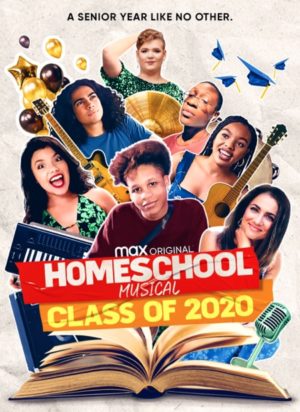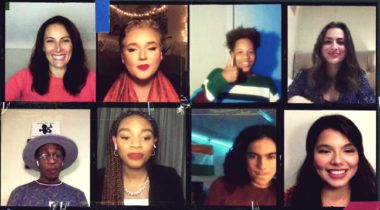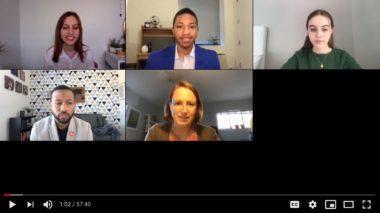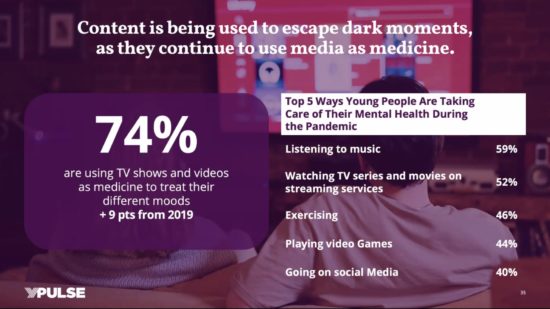So many of us lost heart, our voices, our strength at different points in the past year, and possibly none more than young people. “Since the start of the pandemic, mental health-related emergency department visits increased by 31% for 12-17-year-olds,” Mental Health America cites data from the Centers for Disease Control as showing. And according to YPulse, 64% of Gen Z-ers themselves say their mental health has been or will be negatively impacted by Covid-19, 53% say they’ve felt  lonelier because of Covid and 77% say maintaining their mental health has become more important to them since the start of the pandemic.
lonelier because of Covid and 77% say maintaining their mental health has become more important to them since the start of the pandemic.
So it’s good to know that teens have lots of tools for mental self-care (see chart below). For Generations Y (millennials) and Z combined, interestingly, meditating is No. 4. Music is No. 1 for both generations, individually and collectively, YPulse reports. See also this groundbreaking 2018 report from HopeLab and Well Being Trust (with an update coming out soon). Then there’s the inspiring anecdotal evidence of how, for some teens, art and, for others, activism, helped them not only cope with the pandemic but turn it into a catalyst.
Artist-activists
So let’s go there: first to art and then to activism. There’s no better way to wrap up – and light up – 2020 than these two videos, one highlighting the work of young performers and music makers, the other young activists and change makers.
 Tony Award-winning actor Laura Benanti really felt for all the students who had their high school musicals canceled because of Covid, so last March she announced on Instagram:
Tony Award-winning actor Laura Benanti really felt for all the students who had their high school musicals canceled because of Covid, so last March she announced on Instagram:
“If you would like to sing a song from your musical that was canceled, I want to hear it. I want to hear you.” Her invitation apparently brightened a whole lot of worlds: Tens of thousands of students posted their videos with her hashtag #sunshinesongs, Playbill reports. That project turned into Homeschool Musical: Class of 2020, a delightful, inspiring one-hour documentary produced by Benanti and just released on HBO Max. The film zooms in on seven of those thousands of students – Joseph, 19, in West Orange, N.J.; Alana, 18, in New Braunfels, Tex.; Isaiah, 18, in Douglasville, Ga., Fischer, 18, in Dayton, Oh.; Annie, 18, in Indianapolis; Jeffrey, 17, in Jackson, Miss.; and Elizabeth, 18, in San Antonio. Each performs a song that reflects their 2020. Each describes their mental struggles of the past year and what got them through.
Three themes emerged from their stories: They found they had to get still and “look inside themselves” to overcome what they faced; they found strength in community (family, friends, fellow artists, their larger community); they want to make the world better, with their art and – for Joseph, in particular – their activism. Here’s a tiny sampler of their powerful voices:
-

Clockwise from top-left: Laura Benanti, Fischer Barnett, Jeffrey Cornelius, Annie Leppert, Isaiah Valbrun, Alana Bright, Joseph Nalieth, Elizabeth Ramirez Alana, who performs “Lift Every Voice and Sing / I Can’t Breathe” by H.E.R.: “I realized…that black joy is radical. Being joyful in a world where black people are killed for no reason at all is a protest within itself. I realized that sometimes you have to be still, to really look inside yourself and heal and breathe and use that time to think and to bring myself peace…. I think my generation is going to accomplish true acceptance….”
- Fischer, who performs “Dog Days Are Over” by Florence + The Machine: “We also have that community mindset where it’s made our ability to see and hear each other a lot stronger…. I made a lot of discoveries over quarantine…. And I’m so grateful for that, because I look at things in a totally different way now…. The fact that I’m ok with myself for the first time in 18 years means more than anyone else’s opinion of me.”
- Jeffrey, who plays nine instruments (though not all in his performance of “Pray,” by Sam Smith), tells how he lost his musical voice for a while with the powerful sense of isolation he felt while quarantining. “I went through times where I had nothing else to do but pray.” But now: “I would not be as bold as I am today, I would not be as unapologetic as I am today had it not been for quarantine.” About his generation compared to that of his grandparents, who were civil rights activists: “The difference is now this change is being hyper-accelerated. Because we have the Internet. Because we have social media…. It’s so hard to not see what’s going on in the news…. I’m looking forward to becoming a better person, a better performer, a better activist, a better ally. I’m looking forward to making art that makes people think and that challenges what they once believed to be true…. when there aren’t words, there’s music.”
- Annie, who performs “My Future,” by Billie Eilish: “The difference between the music that I wrote before quarantine and during quarantine time was the significance…. I was reaching people at a time when people seemed so untouchable.”
- Joseph, who performs “It’s the End of the World As We Know It (and I Feel Fine), by R.E.M.: “Growing up alongside the internet…has made us a much more conscious generation…. With a number of friends from my high school, we banded together and started the West Orange Youth Caucus” that organized a protest rally of 3,000 people in front of the town hall. “We got 8,000 signatures on our petition and presented it to the mayor asking for accountability in policing, to ensure transparency, to ban the use of chokeholds in arrests, to ban the use of rubber bullets and teargas on crowds, to require by ordinance a bodycam on all active-duty police officers…. Almost everything we demanded ended up being passed by our town council.”
- Elizabeth, who performs “Somewhere” from West Side Story: Telling of how her hopes of starting university were crushed when her family’s only source of income, their store in San Antonio, had to close due to Covid, “It’s a world where there’s a lot of crazy and unrest, and right now what we need is peace and quiet and hope. There is a driving hope in this song.”
- Isaiah, who performs “I Will Survive,” by Gloria Gaynor, and whose family lost their home at some point during the year: “So much happened. I went through the mud. I went through the grass, the tornado, the ocean, the desert, the tundra, every biome on the planet, and yet I’m talking to one of my idols. Hello. I came out on top.… I want to tell my 14-year-old self, ‘You have so much strength and resilience and power that you just don’t know about because you’re so young. But when you get there … you will love it.’”

Activism is their art, their work
There were three amazing young activists in this panel discussion at the Family Online Safety Institute conference last month. After each one’s name and affiliation, here are key responses to questions from moderator Amanda Lenhart of Georgetown University’s Data & Society Research Institute about how technology supports their work:
Alexandria Villaseñor, climate activist and co-founder, Earth Uprising:
Social media is “the most important way we translate activism into the real world – it’s how we meet each other across countries and continents…. The ability to see what’s happening in real time has become so much more important.” When asked what she would say to adults about today’s media: “Adults think all social media is the same. Every platform is used so differently and is important in its own way. Using SM is … not all fun and not all socializing. It’s now a platform to get work done…. Using all the platforms, we flood social media every Friday with messages about the climate crisis.”
Jerome Foster II, 18, founding executive director of OneMillionOfUs (former intern for congressman and civil rights activist John Lewis, who died this year):
“A lot of adults underestimate us – they think using social media is not making an impact…. They underestimate our skill… We consume information at a faster rate [than watching a TV ad or reading a newspaper]. They see our work in social media as a temporary fad…. [With social media] we have so many outlets to voice our opinion…. We’re creating a movement every time we tweet. When we get 2,000 responses, that’s a march right there…. Our generation is uniting across the planet.”
Julia Morgan-Canales, a 16-year-old activist in New York City:
Julia pointed out that this year has seen “a huge rise of young people making political movements on TikTok.” I got the sense that she and her peers use TikTok for their activism, while her slightly older fellow panelists use Twitter and Instagram more. Asked about adult perceptions of social media, she said they think that writing “a borderline essay on Instagram” is somehow less real” than writing for print media. About adults’ perceptions of her generation, she said, “[They say], ‘the young people care; they’ll [take care of these crises] in 20 years [when they grow up]’.” Interestingly, she echoes the urgency of both 90-something David Attenborough and her Swedish peer Greta Thunberg. So her advice: “Don’t put it all on our backs. I think it’s kind of disheartening that 13- and 14-year-olds have to worry about every single thing that’s happening in the world instead of focusing on being 13- and 14-year-olds.”
Underscoring what the activists on the panel were saying about the social media part of their work, Reggie McCrimmon of Twitter, who was also on the panel, said that, at 320 million tweets, Black Lives Matter represented 17% of all of the conversation on Twitter, globally, from May 25 to June 10.
Gen Z an ‘undeniable force’
Says 18-year-old Joseph in Homeschool Musical of his generation: “We are the 9/11 babies, this whole class of 2020.” Obviously we’ve been preoccupied with the first global pandemic we’ve all had to deal with, but Joseph points out it’s just one thing our children are facing: “Global pandemic, climate crisis, mass shootings, people losing their jobs, losing their homes.” Then he immediately adds: “We can use our collective bargaining power to send the message to people who are our authority figures: ‘That’s something that has to change.’”
They can. And do. “Gen Z is now an undeniable force in leading the charge on social justice awareness and action. The creators in this generation are using their platforms for good, and I expect their influence to continue to grow as they lead the way tackling hard issues head on,” Darren Lachtman, cofounder of Brat TV, told the market researchers at Zebra IQ.
And in its study of youth mental wellbeing in 2020, Mental Health America concludes: “We must invest in young people’s ideas and leadership, including them in decision-making, and working with them to design communities that are mentally healthy and meet their needs. Young people must be included in creating a vision for the present and future of mental health. There is no more time to wait.” I agree. Never has it been more important – to young people and to all of us who love and work with them – to honor their rights under the 30+ year-old UN Convention thereof, and enable their health, agency, art and activism in every way we can.

Related links
- Laura Benanti performing “Sucker” (by The Jonas Brothers).
- “Why Laura Benanti Says Gen Z Is the ‘Found Generation’” in Playbill (you can follow the stars of her Homeschool Musical on Instragram: Fischer Barnett (@fischerbarnett), Alana Bright (@alanakxy), Jeffrey Cornelius (@thejeffreycornelius), Annie Leppert (@annie.leppert), Joseph Nalieth (@potajoe), Elizabeth Ramirez (@elizabeth.r.t) and Isaiah Valbrun (@isaiahvalbrun)
- “Who Is Gen Z?: Born between 1995 and 2010; 3 billion worldwide; 35% of the global population,” according to Zebra IQ’s “2020 State of Gen Z” report and, according to UNICEF, “an estimated one in three of all Internet users in the world today is below the age of 18.” A couple more data points from Zebra IQ: 65% prefer FaceTime for keeping in touch with their friends, and mobile video is how they keep up with self-education and the news.
- “Five young activists in 4 countries on life, work and social media”: Part 1 and Part 2 (2018)
- The state of global youth, digitally speaking (2017)
- “Student bullying-prevention activists, leaders, mentors” (2012)
- About a 12-year-old activist, author and her book on digital citizenship

[…] About young people’s agency, artistry and activism: For pure inspiration, hear from the young artists and activists themselves (my Dec. 28, 2020 post) […]